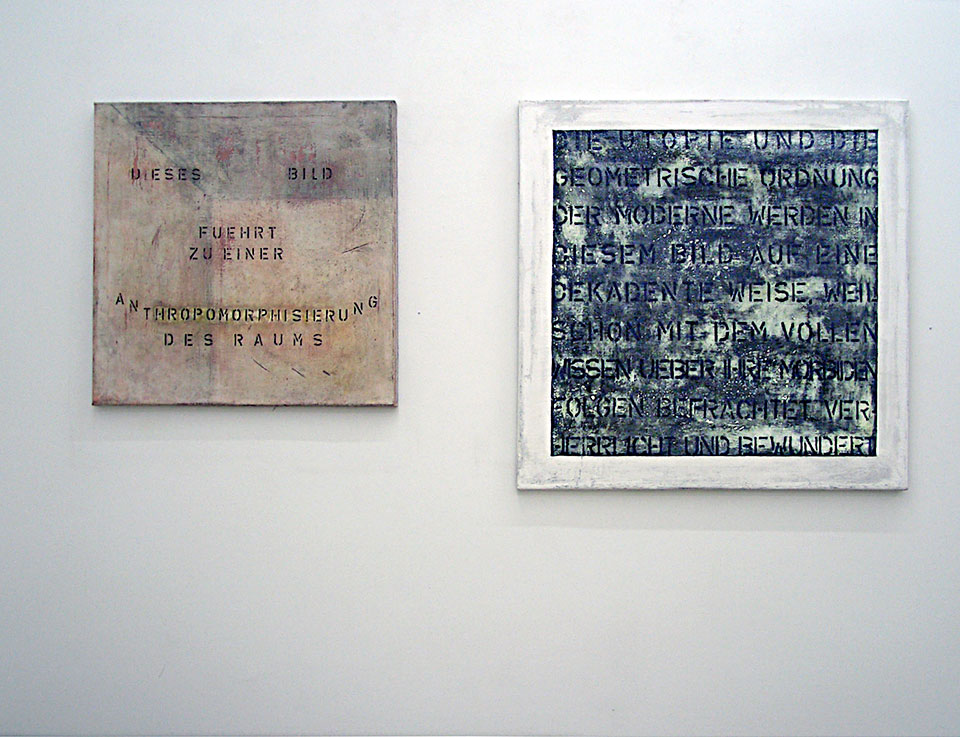Manifest: Kritikbilder!
(English version below) 1 Die mediale Bedeutung von Kunstkritik, Kuratorenwesen und Museumspolitik drängt die der Kunstschaffenden an den Rand. Kunstbewerter und -beschreiber sind wichtiger geworden als die Künstler selbst. Was ist zu tun? Malerinnen und Maler: übt euch in Textverarbeitung! Setzt den geschriebenen Kritiken gemalte entgegen! Die Kunstkritik von heute ist die Kunst von morgen!
2 Im Fundstück steckt Wahrheit: Alle gemalten Texte sind Originalzitate aus kritischen Besprechungen über Kunstwerke. Die Anonymität des Autors ermöglicht eine vorurteilsfreie inhaltliche Auseinandersetzung. Der Kritikmaler garantiert, dass er niemals Kritiken selbst erfindet (allenfalls minimal zuspitzend eingreift) und dass er seine Quellen niemals aufdeckt.
3 Kritikmalerei versteht sich als Bastion gegen die hysterische Bilderproduktion der globalisierten Medien- und Kunstindustrie; als Aufbegehren der „Urkunstform“ Malerei.
4 Kritikmalerei ist einfach, rauh, ärmlich, im besten Sinne „handgemacht“, sie vertraut ausschließlich auf „altmodische“, dem merchandising-konformen Hightech-Establishment zuwiderlaufende Materialien.
5 Text ist das zentrale bildnerische Element; Schriften sind prinzipiell schlicht und schnörkellos, Lesbarkeit - mit streckenweise erwünschtem Aufwand für den Betrachter - ist die einzige typografische Anforderung.
6 Gegenständliche Bildelemente sind möglich, dürfen jedoch maximal optisch gleichgewichtig zum Text erscheinen.
7 Kritikmalerei wendet sich an ein mündiges Publikum: Dieses benötigt längst kein klassisches Gemälde mehr, der Text im Tafelbildrahmen erzeugt im geistigen Auge des Betrachters das bis zu 100% persönliche Tafelbild, da es sich - ohne vorgegebene Bilddarstellung - nur mehr am individuell abgespeicherten, bildnerischen Erfahrungsschatz orientieren kann.
8 Kritikmalerei wendet sich an ein unmündiges Publikum: Die im Bild integrierte Bewertung auf höchstem inhaltlichen und sprachlichen Niveau garantiert eine unvergängliche Rezeption des Werks und damit eine allen schnelllebigen Trends resistente Wertbeständigkeit. Eigenständiges Kunstempfinden und Urteilsvermögen sind somit endlich verzichtbar.
9 Malerei ist nicht tot, sie riecht nur sonderbar.
10 Lackierte Malerei statt gelackter Kunst!
2001
Manifesto: Critical Paintings!
1 In media terms, artists are increasingly marginalized by the significance accredited to art criticism, curatorial concerns, and to museum policy. Those in charge of the appraisal and description of art have gained greater relevance than the artists themselves. What can be done? Painters, you will need to become adept at text processing! Seek to counter the textual critique with a painted one! The art criticism of today shall be the art of tomorrow!
2 The found object contains veracity: every painted text is a faithful quotation taken from the critical discussion of works of art. The author’s anonymity ensures that this inquiry is both content-oriented and unbiased. Hence, the critical painter pledges that he will at no time simply concoct such a critique (at the very most heightening its impact) and that he will under no circumstances reveal his sources.
3 Critical Painting considers itself a bastion against the hysterical image production of the globalized media- and art industry; an insurgence of painting as the archetypical expression of art.
4 Critical Painting is basic, rough, meagre, ‘handmade’ in the most positive meaning of the term, and it relies exclusively on ‘old-fashioned’ materials that refuse to conform to the merchandising constraints of the high-tech establishment.
5 Text supplies the central pictorial element and the typefaces are, by necessity, plain and unadorned. Legibility constitutes the single typographical requirement, even where it - quite intentionally - demands considerable effort on the part of the viewer.
6 The composition may contain representational elements though their visual weight should never exceed that of the text.
7 Critical Painting addresses the independent viewer: This individual no longer hungers for representation. The insertion of the text into the framework of the panel painting has the capacity to produce in the mind’s eye a panel painting that is entirely personal. In the absence of the pre-determined representation the individual’s personal store of pictorial experience provides the single point of reference.
8 Critical Painting addresses the dependent viewer: The subtlety, both in terms of content and language, of the value judgements integrated into the painting ensures the constancy of its interpretation and, therefore, the stability of its value in the face of rapidly changing trends. The independent appraisal of art has finally become superfluous.
9 Painting is not dead, it has just started to smell.
10 Varnished paintings for unvarnished art!
2001
